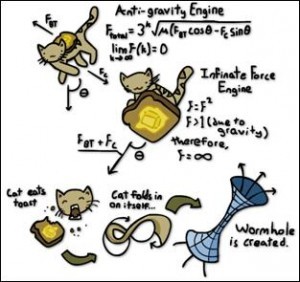Scientists Levitate Baby Mice For Science

NASA scientists have been conducting experiments using magnetic fields to levitate baby mice, partly to study the effects of microgravity on mammalian organisms and partly because they can.
Spending time weightless in space might seem totally awesome (and let's face it, it probably is totally awesome) but it comes at a price: Too much time in microgravity tends to degenerate unused bones and muscles that astronauts tend to need once they return to Earth. So, how do you run tests on ways to prevent this critical atrophying barring expensive spaceflight or that really cool weightlessness simulator (that only gives you a few minutes of microgravity at a time anyway)?
The answer? You levitate animals - with science. Researchers at the Jet Propulsion Laboratory in Pasadena, CA, working on behalf of NASA, used a superconducting magnet that generates a field powerful enough to levitate the water inside living animals to levitate a three-week old mouse and observe what happened.
"It actually kicked around and started to spin, and without friction, it could spin faster and faster, and we think that made it even more disoriented," said researcher Yuanming Liu. Further tests involved minor sedation to keep the animals calm, though the researchers discovered that the mice were able to acclimatize to the lack of gravity quickly, even without being sedated.
[blockquote]"We're trying to see what kind of physiological impact is due to prolonged microgravity, and also what kind of countermeasures might work against it for astronauts," Liu said. "If we can contribute to the future human exploration of space, that would be very exciting."[/blockquote]
Though research on levitation has been already done with grasshoppers and frogs, mice (as mammals) are much closer biologically to humans (and one must imagine that they look much cuter when spinning around in mid-air, too). This, of course, brings us one step closer to personal antigravity devices.
(MSNBC [http://www.msnbc.msn.com/id/32760311/ns/technology_and_science-science/])
Permalink

NASA scientists have been conducting experiments using magnetic fields to levitate baby mice, partly to study the effects of microgravity on mammalian organisms and partly because they can.
Spending time weightless in space might seem totally awesome (and let's face it, it probably is totally awesome) but it comes at a price: Too much time in microgravity tends to degenerate unused bones and muscles that astronauts tend to need once they return to Earth. So, how do you run tests on ways to prevent this critical atrophying barring expensive spaceflight or that really cool weightlessness simulator (that only gives you a few minutes of microgravity at a time anyway)?
The answer? You levitate animals - with science. Researchers at the Jet Propulsion Laboratory in Pasadena, CA, working on behalf of NASA, used a superconducting magnet that generates a field powerful enough to levitate the water inside living animals to levitate a three-week old mouse and observe what happened.
"It actually kicked around and started to spin, and without friction, it could spin faster and faster, and we think that made it even more disoriented," said researcher Yuanming Liu. Further tests involved minor sedation to keep the animals calm, though the researchers discovered that the mice were able to acclimatize to the lack of gravity quickly, even without being sedated.
[blockquote]"We're trying to see what kind of physiological impact is due to prolonged microgravity, and also what kind of countermeasures might work against it for astronauts," Liu said. "If we can contribute to the future human exploration of space, that would be very exciting."[/blockquote]
Though research on levitation has been already done with grasshoppers and frogs, mice (as mammals) are much closer biologically to humans (and one must imagine that they look much cuter when spinning around in mid-air, too). This, of course, brings us one step closer to personal antigravity devices.
(MSNBC [http://www.msnbc.msn.com/id/32760311/ns/technology_and_science-science/])
Permalink



